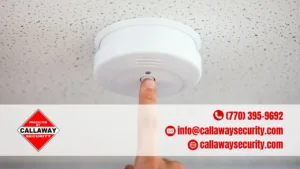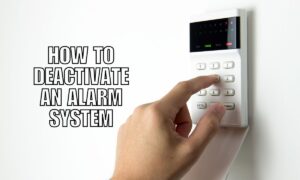Smart home automation is a technology that connects household devices and systems to the internet, allowing remote control and monitoring of various home functions. It enhances daily life by improving convenience, security, and energy efficiency through centralized management of appliances and systems like lighting, heating, security, and entertainment.
Let’s explore the world of smart home automation and how it’s revolutionizing the way we interact with our living spaces. We’ll examine its key features, components, benefits, and much more to give you a comprehensive understanding of this exciting technology.
Key Takeaways:
- Smart home automation integrates internet-connected devices for remote home management
- It offers enhanced convenience, security, and energy efficiency
- Key features include remote control, automation, and device integration
- Components involve sensors, controllers, and actuators
- Benefits range from time-saving to improved comfort and reduced energy costs
Understanding Smart Home Automation
What Makes a Home “Smart”?
A smart home is one where various devices and systems are interconnected and can be controlled remotely. These homes use internet-connected devices to enable remote monitoring and management of appliances and systems. The goal is to provide convenience, improve security, and increase energy efficiency.
The Evolution of Home Automation
Home automation has come a long way from simple programmable thermostats. Today’s smart homes can learn our habits, anticipate our needs, and even make decisions on their own. Let’s look at how this technology has evolved:
- Early automation: Simple timers and programmable devices
- Connected devices: Internet-enabled appliances that can be controlled remotely
- Smart hubs: Central control systems that manage multiple devices
- AI integration: Systems that learn and adapt to user preferences
- Voice control: Integration with virtual assistants for hands-free operation
Core Components of a Smart Home System
To better understand how smart homes work, let’s break down the main components:
- Smart devices: These are the internet-connected appliances and systems in your home, such as:
- Smart thermostats
- Smart lighting
- Smart locks
- Security cameras
- Smart speakers
- Hub or control center: This is the brain of your smart home system. It can be a dedicated device or a software application that coordinates all your smart devices.
- User interface: This is how you interact with your smart home system. It could be:
- A smartphone app
- A voice assistant
- A wall-mounted control panel
- Network: The communication backbone of your smart home, typically Wi-Fi or specialized protocols like Zigbee or Z-Wave.
How Smart Home Devices Communicate
Smart home devices use various communication protocols to interact with each other and the central hub. Some common protocols include:
- Wi-Fi: Used for high-bandwidth devices like cameras
- Bluetooth: For short-range, low-power devices
- Zigbee and Z-Wave: Specialized protocols for home automation
- Thread: A newer protocol designed for low-power mesh networking
The Role of Artificial Intelligence in Smart Homes
Artificial Intelligence (AI) plays a crucial role in making our homes truly “smart.” Here’s how:
- Learning patterns: AI algorithms can learn your daily routines and preferences, adjusting your home’s systems accordingly.
- Predictive maintenance: AI can predict when devices need maintenance or replacement, helping prevent unexpected breakdowns.
- Energy optimization: By analyzing usage patterns and external factors like weather, AI can optimize your home’s energy consumption.
- Enhanced security: AI can distinguish between normal and suspicious activities, improving the effectiveness of your home security system.
Key Features of Smart Home Automation
Remote Monitoring and Control
One of the most appealing aspects of smart home automation is the ability to monitor and control your home from anywhere. Whether you’re at work, on vacation, or just in another room, you can:
- Check your home’s security status
- Adjust the thermostat
- Turn lights on or off
- View live feeds from security cameras
This feature not only provides convenience but also peace of mind, knowing you can always keep an eye on your home.
Automation and Scheduling
Smart homes excel at handling routine tasks automatically. You can set schedules for various devices or create rules that trigger actions based on certain conditions. For example:
- Lights can turn on automatically at sunset
- The thermostat can adjust when you leave for work
- Your coffee maker can start brewing when your alarm goes off
This automation saves time and ensures your home runs efficiently even when you’re not actively managing it.
Device Integration and Scenes
Smart home systems allow devices to work together, creating a more seamless experience. You can create “scenes” that control multiple devices with a single command. For instance:
- A “Movie Night” scene could dim the lights, lower the blinds, and turn on the TV and sound system
- A “Good Morning” scene might gradually increase the lighting, start the coffee maker, and turn on the news
This integration makes it easy to create the perfect ambiance for any situation with minimal effort.
Voice Control and Virtual Assistants
Many smart home systems integrate with virtual assistants like Amazon Alexa, Google Assistant, or Apple’s Siri. This allows you to control your home using voice commands, such as:
- “Turn off all the lights”
- “Set the thermostat to 72 degrees”
- “Lock the front door”
Voice control adds an extra layer of convenience, especially when your hands are full or you’re multitasking.
Components of a Smart Home System
Sensors: The Eyes and Ears of Your Smart Home
Sensors play a crucial role in smart home automation by gathering information about your home environment. They can detect various conditions and trigger appropriate responses. Common types of sensors include:
- Motion sensors: Detect movement in a specific area
- Door/window sensors: Monitor whether doors or windows are open or closed
- Temperature sensors: Measure ambient temperature
- Light sensors: Detect light levels
- Humidity sensors: Measure moisture in the air
These sensors work together to create a comprehensive picture of your home’s status, enabling your smart home system to respond appropriately to changing conditions.
Controllers: The Brains of the Operation
Controllers are the devices you use to manage your smart home system. They receive information from sensors, process it, and send commands to actuators. Controllers can take various forms:
- Smartphones and tablets: The most common way to control smart homes
- Dedicated control panels: Wall-mounted touchscreens specifically for home control
- Voice assistants: Smart speakers that can control your home through voice commands
- Computers: Desktop or laptop computers with smart home control software
Controllers allow you to monitor your home’s status, adjust settings, and create automation rules.
Actuators: Bringing Commands to Life
Actuators are the components that carry out the physical actions in your smart home. They receive commands from controllers and execute them. Examples of actuators include:
- Smart light bulbs: Can turn on/off, dim, or change color
- Smart thermostats: Adjust heating and cooling
- Smart locks: Lock or unlock doors
- Motorized blinds: Open or close window coverings
- Smart plugs: Turn connected devices on or off
Actuators are what make the magic happen in your smart home, translating digital commands into real-world actions.
Benefits of Smart Home Automation
Enhanced Convenience and Time Savings
Smart home automation can significantly simplify your daily routines and save you time. Here’s how:
- Automated tasks: Your home can handle routine tasks without your intervention
- Remote control: Manage your home from anywhere, anytime
- Voice commands: Control devices hands-free
- Personalized settings: Your home adapts to your preferences automatically
These features free up your time and mental energy, allowing you to focus on more important things.
Improved Energy Efficiency and Cost Savings
Smart homes can help you reduce energy consumption and lower your utility bills:
- Smart thermostats: Learn your habits and optimize heating/cooling
- Automated lighting: Ensures lights are only on when needed
- Energy monitoring: Provides insights into your energy usage
- Smart appliances: Operate at peak efficiency and during off-peak hours
By optimizing energy use, smart homes not only save you money but also reduce your environmental impact.
Enhanced Home Security
Smart home technology can significantly boost your home’s security:
- Smart locks: Allow keyless entry and remote locking/unlocking
- Security cameras: Provide live video feeds and motion alerts
- Smart doorbells: Let you see and speak to visitors remotely
- Automated lighting: Can simulate occupancy when you’re away
These features provide peace of mind and can deter potential intruders.
Increased Comfort and Personalization
Smart homes can create a more comfortable living environment tailored to your preferences:
- Adaptive climate control: Maintains ideal temperature and humidity
- Smart lighting: Adjusts brightness and color to suit your mood or activity
- Personalized entertainment: Customizes audio and video settings for each user
- Automated routines: Creates the perfect ambiance for different times of day
With smart home automation, your living space becomes more responsive to your needs and preferences.
Challenges and Considerations
Privacy and Security Concerns
While smart homes offer numerous benefits, they also raise important privacy and security considerations:
- Data collection: Smart devices gather a lot of data about your habits and preferences
- Potential vulnerabilities: Internet-connected devices can be targets for hackers
- Third-party access: Some systems may share data with manufacturers or service providers
To address these concerns:
- Choose reputable brands with strong security practices
- Regularly update device firmware
- Use strong, unique passwords for all devices and accounts
- Consider using a separate network for your smart home devices
Compatibility and Integration Issues
As the smart home market grows, compatibility between devices from different manufacturers can be a challenge:
- Different communication protocols: Not all devices speak the same “language”
- Proprietary systems: Some brands only work within their own ecosystem
- Frequent updates: Software changes can sometimes break integrations
To mitigate these issues:
- Research compatibility before purchasing new devices
- Consider using a universal hub that supports multiple protocols
- Look for devices that support open standards like Matter or HomeKit
Initial Costs and Long-term Value
Setting up a smart home can involve significant upfront costs:
- Smart devices are often more expensive than their traditional counterparts
- You may need to upgrade your home’s Wi-Fi network
- Professional installation might be required for some systems
However, the long-term benefits often outweigh these initial costs:
- Energy savings can offset device costs over time
- Increased home value and appeal to potential buyers
- Improved quality of life and convenience
Consider starting small and expanding your smart home system gradually to manage costs.
Frequently Asked Questions
How do I start automating my home?
Starting your smart home journey can be simple:
- Choose a central platform (like Amazon Alexa, Google Home, or Apple HomeKit)
- Start with a few basic devices (smart bulbs, a smart plug, or a smart speaker)
- Familiarize yourself with the system and gradually add more devices
- Experiment with automation rules and schedules
Remember, you don’t need to automate everything at once. Start small and expand as you become more comfortable with the technology.
Are smart homes secure?
Smart homes can be secure if proper precautions are taken:
- Use strong, unique passwords for all devices and accounts
- Keep all devices updated with the latest firmware
- Choose devices from reputable manufacturers with good security track records
- Consider using a separate network for your smart home devices
- Be cautious about which third-party services you connect to your smart home system
While no system is 100% secure, these steps can significantly reduce the risk of unauthorized access.
Can I install a smart home system myself?
Many smart home devices are designed for easy DIY installation. However, some components, particularly those involving electrical work, may require professional installation. Here’s a general guide:
DIY-friendly:
- Smart plugs
- Smart bulbs
- Battery-powered sensors
- Smart speakers
May require professional installation:
- Smart thermostats
- Hardwired security systems
- Smart switches (if you’re not comfortable with electrical work)
Always prioritize safety and consult a professional if you’re unsure.
The Future of Smart Homes
As we look ahead, the future of smart home technology is bright and full of exciting possibilities. Here are some trends we can expect to see:
AI and Machine Learning Advancements
Artificial Intelligence and Machine Learning will play an increasingly important role in smart homes:
- More sophisticated learning algorithms will better anticipate our needs
- AI-powered voice assistants will become more natural and context-aware
- Predictive maintenance will help prevent device failures before they occur
These advancements will make our homes even more intuitive and responsive to our needs.
Integration with Smart Cities
As cities become smarter, our homes will increasingly interact with the broader urban environment:
- Smart grids will optimize energy distribution
- Connected transportation systems will inform our home’s routines
- Public safety information will be integrated into home security systems
This integration will create a more seamless experience between our homes and the world around us.
Health and Wellness Focus
Smart homes will play a larger role in maintaining our health and wellness:
- Air quality monitoring and purification
- Sleep tracking and optimization
- Stress reduction through adaptive lighting and sound
These features will transform our homes into proactive partners in our health and well-being.
Sustainable Living
Smart homes will become key players in promoting sustainable living:
- Advanced energy management systems
- Integration with renewable energy sources
- Water conservation through smart irrigation and leak detection
These innovations will help us reduce our environmental impact while maintaining comfort and convenience.
Smart Home Automation: Transforming Living Spaces
Smart home automation is transforming the way we interact with our living spaces. By enhancing convenience, security, and efficiency, smart homes are becoming an integral part of modern living. As technology continues to advance, we can look forward to even more innovative and intuitive ways for our homes to support and enhance our daily lives. Contact Callaway Security™™ for more.










